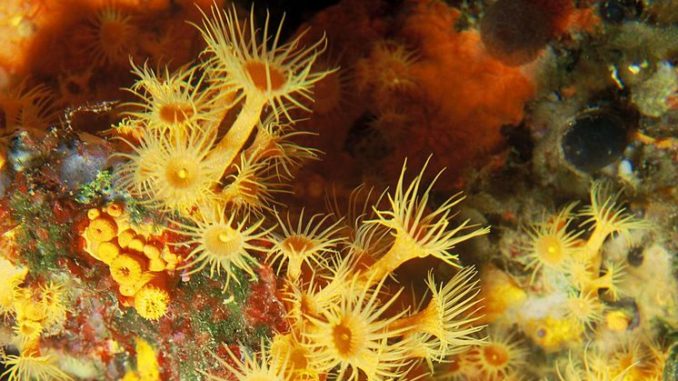
Coral species come in an amazing and impressive variety of shapes, sizes, colors, textures (soft or stony), and even reproductive schemes. The environments they live in also vary widely as different species of coral may live in shallow waters or deep depths, or warm tropical seas, or cold arctic oceans. Indeed, corals have been found in the North Atlantic Ocean northwest of Scotland, and along the Aleutian Islands archipelago in the northernmost reaches of the Pacific. All corals are animals, not plants (as was once argued in ancient times). Their taxonomic classification begins as follows;
- Kingdom: Animalia
- Phylum: Cnidaria
- Class: Anthozoa
The classification under Anthozoa diverges greatly here. Tonight, the Owl is interested in one particular coral species which is further classified as;
- Order: Zoantharia
- Family: Parazoanthidae
- Genus: Parazoanthus
- Species: P. axinellae
Parazoanthus axinellae is a soft coral species, meaning it has no exoskeleton as stony corals do. Each polyp (the tube with tentacles in the picture) is a separate animal but they exist in a single interconnected colony. The tissue that connects them all together into one colony is the coenenchyme. Their native habitat is the Mediterranean Sea and the eastern Atlantic Ocean along the coasts of Europe and the United Kingdom.
The common name for P. axinellae is yellow encrusting anemone, but it’s not a true sea anemone. The two main differences between P. axinellae and the sea anemone is their different internal anatomies and the fact that P. axinellae possesses the coenenchyme, forming an actual colony. The colony may form on rock, disused worm tubes, or on living sea creatures including hydroids, gorgonians, and sponges.
Each yellow encrusting anemone has between two and three dozen tentacles. The polyp tubes are small, no more than 20 millimeters (slightly more than 3/4 inch) long and 5 millimeters (less than 1/4 inch) in diameter.
Zoanthids, of which P. axinellae is a member, feed on plankton and particulates that pass by, floating on ocean currents. The tentacles sting their prey with palytoxin, a deadly organic poison. The polyp gathers additional nutrition through photosynthesis. This is possible through a symbiotic relationship with zooxanthellae, an algae that becomes an integrated part of the body of the animal.
Zoanthids are colorful, popular choices among hobbyists for salt water aquariums.
Question of the night: Who is your favorite bald actor, and would they be better with hair? (Receding hairlines count, too. There are a surprisingly large number who qualify to compete in this contest, so think it over carefully. No do-overs. Internet searches permitted.)
